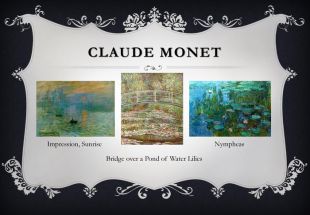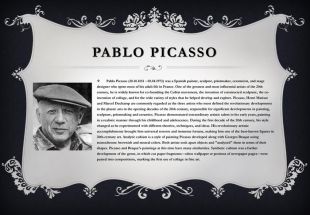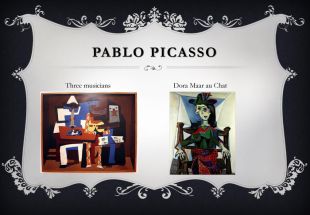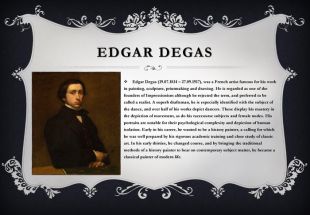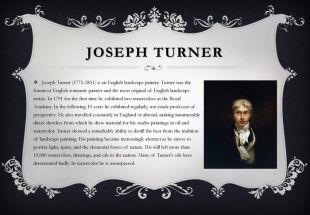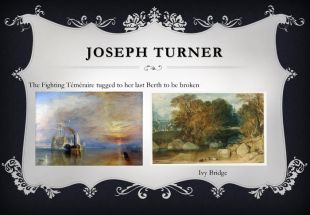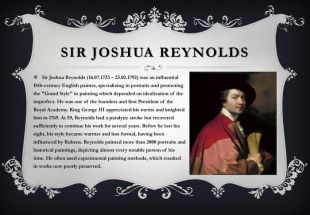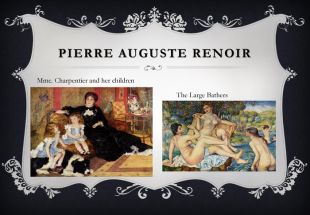Презентація для учнів старших класів на тему "Відомі художники 17-20 ст."
Презентація на тему "Відомі художники 17-20 ст." може бути використана, як додатковий компонент при вивченні теми "Мистецтво" у старших класах. Мета даної роботи– збагачувати словниковий запас учнів; практикувати учнів у читанні тексту з метою отримання загального уявлення (skimming) та максимально повного й точного розуміння всієї інформації, що міститься в тексті (scanning); удосконалювати навички читання й усного мовлення; формувати навички вимови. Дана презентація базується на автентичному матеріалі.




























Sir Anthony Van Dyck. Sir Anthony Van Dyck (1599-1641) is a Flemish portrait and religious painter and etcher. In1618 he was received as a master in the artists’ guild, but even before this he produced independent paintings in his studio. For a few years he was the skilled assistant and close collaboration of Rubens. He was also summoned to England by James I, whose portrait he painted. In his portraits he conferred upon his sitters’ elegance, dignity, and refinement, qualities pleasing to royalty and aristocracy. In Antwerp he painted his masterly “Lamentation”, his best portrait. The work of Van Dyck differs radically from Rubens’ although it is similar in technique. The colour is much more restrained, the form more refined, although his best work has an essential vigor. Van Dyck produced a fine series of etched portraits known as the “Iconography”.
William Hogarth William Hogarth (10.11.1697 – 26.10.1764) was an English painter, printmaker, pictorial satirist, social critic and editorial cartoonist who has been credited with pioneering western sequential art. His work ranged from realistic portraiture to comic strip-like series of pictures called "modern moral subjects". Hogarth was also a popular portrait painter. In 1746 he painted actor David Garrick as Richard III. In the same year a sketch of Simon Fraser, 11th Lord Lovat, had an exceptional success. Hogarth's truthful, vivid full-length portrait of his friend, the philanthropic Captain Coram and his unfinished oil sketch of” The Shrimp Girl” may be called masterpieces of British painting. “The Shrimp Girl” is an unsurpassed masterpiece, depicted in bright colours and quick brush strokes. The image of a laughing, cheerful common girl is contrasted to the ugly world of vices and corruption. In this portrait, the artist managed to capture the girl’s expression and the mood of the moment. Her face and everything is young and fresh. Simple and real-life atmosphere, illuminated by youth, is joyous and lovely. There are also portraits of his wife and his two sisters and of many other people, among them Bishop Hoadly and Bishop Herring.
Rembrandt van Rijn. Rembrandt van Rijn (15.07.1606 – 04.10.1669) was a Dutch painter and etcher. He is generally considered one of the greatest painters and printmakers in the European art history and the most important in Dutch history. His contributions to art came in a period of great wealth and cultural achievement that historians call the Dutch Golden Age when painting was extremely prolific and innovative. Having achieved youthful success as a portrait painter, Rembrandt's later years were marked by personal tragedy and financial hardships. Yet his etchings and paintings were popular throughout his lifetime, his reputation as an artist remained high, and for twenty years he taught many important Dutch painters. Rembrandt's greatest creative triumphs are exemplified especially in his portraits of his contemporaries, 100 self-portraits and illustrations of scenes from the Bible. His self-portraits form a unique and intimate biography, in which the artist surveyed himself without vanity and with the utmost sincerity. In his paintings and prints he exhibited knowledge of classical iconography, which he molded to fit the requirements of his own experience; thus, the depiction of a biblical scene was informed by Rembrandt's knowledge of the specific text, his assimilation of classical composition, and his observations of Amsterdam's Jewish population. The prodigious output of his lifetime is known to embrace more than 600 paintings, 300 etchings and nearly 2,000 drawings.
Claude Monet. Claude Monet (14.11.1840 – 05.12.1926) was one of the founders of French impressionist painting, and the most consistent and prolific practitioner of the movement's philosophy of expressing one's perceptions before nature, especially as applied to plain-air landscape painting. The term Impressionism is derived from the title of his painting “Impression”, “Sunrise”. These artists were called impressionists because they painted outdoors and developed a sketchy “impressionistic” style, trying to capture the changing effect of natural light. It’s better to look at Monet’s pictures from a distance because his pictures are made of thousands of coloured dots, which merge together and form the objects. In this way the artist expressed his impressions. Throughout his long career, Monet consistently depicted the landscape and leisure activities of Paris and its environs as well as the Normandy coast. He led the way to twentieth-century modernism by developing a unique style that strove to capture on canvas the very act of perceiving nature. He was making several series of studies of the same object at different times of the day or year: haystacks, morning views of the Seine, poplars, the Thames. Monet found subjects in his immediate surroundings, as he painted the people and places he knew best. His first wife, Camille and his second wife, Alice, frequently served as models. In the 1910s and '20s, Monet focused almost exclusively on the picturesque water-lily pond that he created on his property at Giverny. In the last decade of his life, nearly blind, Monet painted a group of large water lily murals “Nympheas”.
Vincent Willem van Gogh. Vincent Willem van Gogh (30.03.1853 – 29.07.1890) was a Dutch post-Impressionist painter whose work, notable for its rough beauty, emotional honesty and bold colour, had a far-reaching influence on 20th-century art. Van Gogh began to draw as a child, and he continued to draw throughout the years that led up to his decision to become an artist. He did not begin painting until his late twenties, completing many of his best-known works during the last two years of his life. In just over a decade, he produced more than 2,100 artworks, consisting of 860 oil paintings and more than 1,300 watercolors, drawings, sketches and prints. His work included self portraits, landscapes, still lives of flowers, portraits and paintings of cypresses, wheat fields and sunflowers. Van Gogh was a prolific self-portraitist, who painted himself 37 times. Van Gogh, known for his landscapes, seemed to find painting portraits his greatest ambition. He said of portrait studies, "The only thing in painting that excites me to the depths of my soul, and which makes me feel the infinite more than anything else." Tragically, Van Gogh died not knowing the acclaim his art would receive. Today his legacy is immortal and he will be forever known as one of the greatest artists of the modern era.
John Constable. John Constable (11.06.1776 – 31.03.1837) was an English Romantic painter, known principally for his landscape paintings of Dedham Vale, the area surrounding his home—now known as "Constable Country". His most famous paintings include “Dedham Vale” and “The Hay Wain” which won gold medal. Although his paintings are now among the most popular and valuable in British art, he was never financially successful and did not become a member of the establishment until he was elected to the Royal Academy at the age of 52. He sold more paintings in France than in his native England. Constable painted many full-scale preliminary sketches of his landscapes in order to test the composition in advance of finished pictures. These large sketches, with their free and vigorous brushwork, were revolutionary at the time, and they continue to interest artists, scholars and the general public. The oil sketches of “The Leaping Horse “and “The Hay Wain”, for example, convey a vigour and expressiveness missing from Constable's finished paintings of the same subjects. Possibly more than any other aspect of Constable's work, the oil sketches reveal him in retrospect to have been an avant-garde painter, one who demonstrated that landscape painting could be taken in a totally new direction.
Thomas Gainsborough Thomas Gainsborough (14.05.1727 – 02.08.1788) was an English portrait and landscape painter. In 1769, he became a founding member of the Royal Academy, but his relationship with the organization was thorny and he sometimes withdrew his work from exhibition. Gainsborough moved to London in 1774, and painted portraits of the King and Queen, but the King was obliged to name as royal painter Gainsborough's rival Joshua Reynolds. In his last years, Gainsborough painted relatively simple landscapes and is credited as the originator of the 18th century British landscape school. Gainsborough died of cancer. He painted quickly and his later pictures are characterized by a light palette and easy strokes. He preferred landscapes to portraits. He painted all parts of his pictures himself, an unusual practice for his day. He left a large collection of landscape drawings. Gainsborough was, with Reynolds, the leading portrait painter in England in the later 18th century. The feathery brushwork of his mature work and rich sense of colour contribute to the enduring popularity of his portraits. Unlike Reynolds, he avoids references to Italian Renaissance art or the antique, and shows his sitters in fashionable contemporary dress.
Pablo Picasso Pablo Picasso (20.10.1881 – 08.04.1973) was a Spanish painter, sculptor, printmaker, ceramicist, and stage designer who spent most of his adult life in France. One of the greatest and most influential artists of the 20th century, he is widely known for co-founding the Cubist movement, the invention of constructed sculpture, the co-invention of collage, and for the wide variety of styles that he helped develop and explore. Picasso, Henri Matisse and Marcel Duchamp are commonly regarded as the three artists who most defined the revolutionary developments in the plastic arts in the opening decades of the 20th century, responsible for significant developments in painting, sculpture, printmaking and ceramics. Picasso demonstrated extraordinary artistic talent in his early years, painting in a realistic manner through his childhood and adolescence. During the first decade of the 20th century, his style changed as he experimented with different theories, techniques, and ideas. His revolutionary artistic accomplishments brought him universal renown and immense fortune, making him one of the best-known figures in 20th-century art. Analytic cubism is a style of painting Picasso developed along with Georges Braque using monochrome brownish and neutral colors. Both artists took apart objects and "analyzed" them in terms of their shapes. Picasso and Braque’s paintings at this time have many similarities. Synthetic cubism was a further development of the genre, in which cut paper fragments—often wallpaper or portions of newspaper pages—were pasted into compositions, marking the first use of collage in fine art.
Henri Paul Gauguin Henri Paul Gauguin (07.07.1848 – 08.05.1903) was a leading French Post-Impressionist artist who was not well appreciated until after his death. Gauguin was later recognized for his experimental use of colours and synthetic style that were distinguishably different from Impressionism. His work was influential to the French avant-garde and many modern artists, such as Pablo Picasso, and Henri Matisse. Gauguin’s art became popular after his death and many of his paintings were in the possession of Russian collector Sergei Shyshkin. He was an important figure in the Symbolist movement as a painter, sculptor, print-maker, ceramist, and writer. His bold experimentation with coloring led directly to the Synthetist style of modern art, while his expression of the inherent meaning of the subjects in his paintings, under the influence of the cloisonnist style, paved the way to Primitivism and the return to the pastoral. He was also an influential proponent of wood engraving and woodcuts as art forms.
Edgar Degas Edgar Degas (19.07.1834 – 27.09.1917), was a French artist famous for his work in painting, sculpture, printmaking and drawing. He is regarded as one of the founders of Impressionism although he rejected the term, and preferred to be called a realist. A superb draftsman, he is especially identified with the subject of the dance, and over half of his works depict dancers. These display his mastery in the depiction of movement, as do his racecourse subjects and female nudes. His portraits are notable for their psychological complexity and depiction of human isolation. Early in his career, he wanted to be a history painter, a calling for which he was well prepared by his rigorous academic training and close study of classic art. In his early thirties, he changed course, and by bringing the traditional methods of a history painter to bear on contemporary subject matter, he became a classical painter of modern life.
Joseph Turner Joseph Turner (1775-1851) is an English landscape painter. Turner was the foremost English romantic painter and the most original of English landscape artists. In 1791 for the first time he exhibited two watercolors at the Royal Academy. In the following 10 years he exhibited regularly, was made professor of perspective. He also travelled constantly in England or abroad, making innumerable direct sketches from which he drew material for his studio paintings in oil and watercolor. Turner showed a remarkably ability to distill the best from the tradition of landscape painting. His painting became increasingly abstract as he strove to portray light, space, and the elemental forces of nature. His will left more than 19,000 watercolors, drawings, and oils to the nation. Many of Turner’s oils have deteriorated badly. In watercolor he is unsurpassed.
Sir Joshua Reynolds Sir Joshua Reynolds (16.07.1723 – 23.02.1792) was an influential 18th-century English painter, specializing in portraits and promoting the "Grand Style" in painting which depended on idealization of the imperfect. He was one of the founders and first President of the Royal Academy. King George III appreciated his merits and knighted him in 1769. At 59, Reynolds had a paralytic stroke but recovered sufficiently to continue his work for several years. Before he lost his sight, his style became warmer and less formal, having been influenced by Rubens. Reynolds painted more than 2000 portraits and historical paintings, depicting almost every notable person of his time. He often used experimental painting methods, which resulted in works now poorly preserved.
Pierre Auguste Renoir Pierre Auguste Renoir (1841-1919) is a French impressionist painter and sculptor. In 1862 he formed lasting friendship with Monet, Sisley. His early work reflected myriad influences including those of Coubert, Manet and Delacroix. He began to earn his living with portraiture, and an important work at this period was “Madame Charpentier and her children”. Simultaneously he developed the ability to paint joyous, shimmering colour and flickering light in outdoor scenes such as “The Swing” and the festive “Moulin de la Galette”. After a brief period, often termed “harsh” or “tight”, in which his forms were closely defined in outline, his style of the 1890s changed, diffusing both light and outline, and with dazzling colours describing voluptuous nudes, radiant children, and lush summer landscapes. Despite illness and personal tragedy he began to produce major works of sculpture “Victorious Venus” and paintings “Dance at Bougival”, “Bather”, “Lady Sewing”.


про публікацію авторської розробки
Додати розробку









